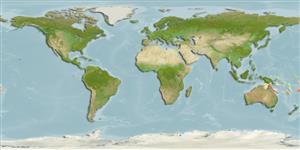>
Eupercaria/misc (Various families in series Eupercaria) >
Labridae (Wrasses) > Cheilininae
Etymology: Cirrhilabrus: Latin, cirrus = curl fringe + Greek, labros = furious (Ref. 45335); squirei: Named for Lyle Squire of Cairns Marine..
Environment: milieu / climate zone / depth range / distribution range
Ecología
marino asociado a arrecife; rango de profundidad 28 - 65 m (Ref. 118208). Tropical
Distribución
Países | Áreas FAO | Ecosistemas | Ocurrencias, apariciones | Point map | Introducciones | Faunafri
Western Pacific: Australia.
Tamaño / Peso / Age
Maturity: Lm ? range ? - ? cm
Max length : 5.6 cm SL macho / no sexado; (Ref. 118208)
Short description
Morfología | Morfometría
Espinas dorsales (total): 11; Radios blandos dorsales (total): 9; Espinas anales 3; Radios blandos anales: 9; Vértebra: 25. This species is distinguished by the following characters: D XI,9 (a female paratype with XII,9); A III,9; pectoral rays 15; lateral line scales 17+7; median predorsal scales 5; horizontal rows of scales on cheek 2; gill rakers 13-15; body depth 2.85-3.40 in SL, width 1.95-2.15 in body depth; head length 2.75-2.90 in SL; snout length 4.1-4.4 in HL; short pelvic fin, not reaching base of the anal fin, 4.15-4.65 in SL; rounded to truncate caudal fin in females and moderately to strongly lunate in males, caudal concavity as great as 0.8 in head; large eye, orbit diameter 3.55-3.90 in HL; colour in life with body yellow shading yellow white on abdomen, 5 irregular red orange bands, yellow dorsal fin with spinous portion having dusky spots on outer part, black on the first membrane, a central lavender band becoming black toward soft rays and soft portion with a black central band abruptly translucent posteriorly, the anal fin yellow, soft portion with a broad lavender black central band becoming narrower on the spinous part, the caudal fin yellow with 7 dusky black tongue-shaped extensions on the innermost rays; colour when preserved, males pale yellow and bands mentioned above on dorsal, anal and caudal fins are dusky to black, paired fins translucent (Ref. 118208).
Life cycle and mating behavior
Madurez | Reproducción | Puesta | Huevos | Fecundidad | Larva
Walsh, F.M., 2014. Cirrhilabrus squirei, a new wrasse (Perciformes; Labridae) from the Great Barrier Reef and Coral Sea, Australia. aqua, Int. J. Ichthyol. 20(3): 123-130. (Ref. 118208)
IUCN Red List Status (Ref. 130435)
Threat to humans
Harmless
Human uses
Más información
PaísesÁreas FAOEcosistemasOcurrencias, aparicionesIntroduccionesStocksEcologíaDietacomponentes alimenticiosconsumo de alimentoRación
Nombres comunesSinónimosMetabolismoDespredadoresEcotoxicologíaReproducciónMadurezPuestaAgregación para la puestaFecundidadHuevosEgg development
Age/SizeCrecimientoLength-weightLength-lengthLength-frequenciesMorfometríaMorfologíaLarvaDinámica larvariaReclutamientoAbundanciaBRUVS
ReferenciasAcuiculturaPerfil de acuiculturaRazasGenéticaElectrophoresesheritabilidadEnfermedadesProcesamientoNutrientsMass conversion
ColaboradoresImágenesStamps, Coins Misc.SonidosCiguateraVelocidadTipo de nataciónSuperficie branquialOtolitosCerebrosVisión
Herramientas
Special reports
Download XML
Fuentes de Internet
Estimates based on models
Phylogenetic diversity index (Ref.
82804): PD
50 = 0.5000 [Uniqueness, from 0.5 = low to 2.0 = high].
Bayesian length-weight: a=0.01585 (0.00707 - 0.03555), b=2.95 (2.76 - 3.14), in cm total length, based on LWR estimates for this (Sub)family-body shape (Ref.
93245).
Nivel trófico (Ref.
69278): 3.3 ±0.4 se; based on size and trophs of closest relatives
Resiliencia (Ref.
120179): Alto, población duplicada en un tiempo mínimo inferior a 15 meses (Preliminary K or Fecundity.).
Fishing Vulnerability (Ref.
59153): Low vulnerability (10 of 100).
